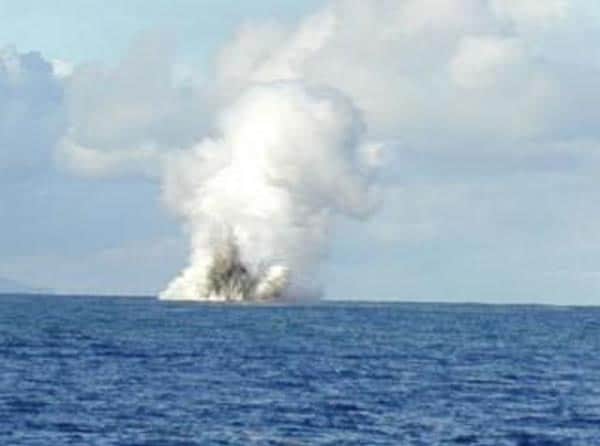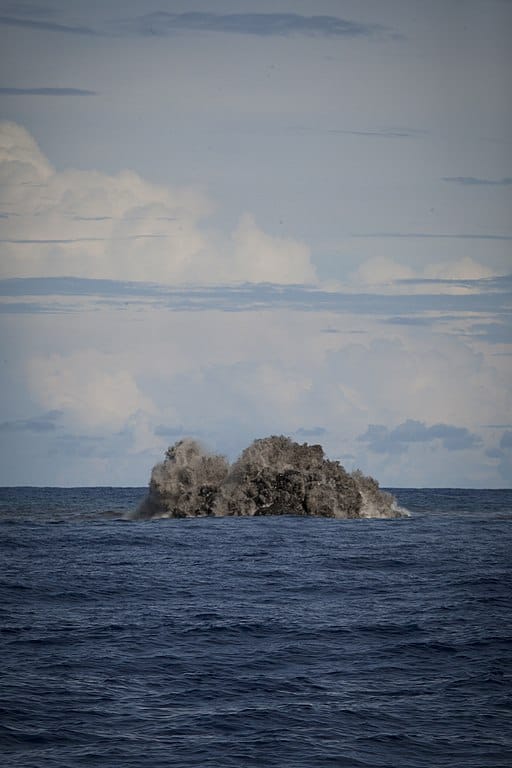Volcanoes and sharks are two of nature’s most powerful and extreme forces, and they are both terrifying and fascinating. The combination of these two would only happen in a cheesy science fiction film, right? Wrong. Stranger things have certainly happened, but this could be the first of many. “Sharkcano” isn’t just the name of a campy summer film. It’s the name of a real-life phenomenon discovered by scientists on an expedition in 2015 when they found sharks living within one of the world’s most active underwater volcanoes. But how can sharks survive in a volcano? For the time being, this and several other research questions raised by “Sharkcano” remain unclear. However, people worldwide are fascinated by the interesting geomorphological feature, which includes sharks roaming around a dangerous lava-spewing vent. This article will explore the true story behind volcano sharks and other interesting facts.
What is the Kavachi Volcano?

The Kavachi Volcano is known as the Sharkcano.
©National Oceanic and Atmospheric Administration / public domain – License
The Solomon Islands are home to the infamous “Sharkcano,” also known as the Kavachi Volcano. The sea god “Kavachi” inspired this volcano’s name and is also known on the islands as “Rejo te Kvachi” or “Kavachi’s Oven.” Kavachi is a Pacific Ocean submarine volcano that is one of the most active on Earth. The volcano’s first officially recorded eruption occurred in 1939, and it has been continually erupting since then.
Kavachi has formed a handful of small islands spread up to a kilometer in length during its known existence. On the other hand, the ocean’s waves have always corroded and washed away these islands. It also creates magnificent phreatomagmatic eruptions, in which superheated magma collides with water, resulting in powerful, steamy explosions. Nobody knows how frequently Kavachi explodes. Even when it isn’t spewing lava, the ash and steam rising to the surface can be too much for divers to handle. Those approaching the volcano’s rim have been forced to retreat due to the acidic water’s heat or minor skin burns.
An international team avoided this risk by sending down submersible robots equipped with underwater cameras to investigate Kavachi’s hostile environment. Despite the harsh conditions, they discovered a variety of animals in Kavachi, including jellyfish, crabs, stingrays, and sharks. Their 2015 expedition identified two shark species, hammerhead and silky sharks, and active microbial ecosystems living within the volcano’s crater, earning the moniker “Sharkcano.” According to the researchers, Kavachi is a “fascinating natural laboratory” that “remains full of secrets to explore.”
Can Sharks Really Survive in a Volcano?

Sharks can be found dwelling within a subterranean volcano.
©Shpatak/Shutterstock.com
As you might expect, the harsh environmental conditions of an underwater volcano are not particularly kind to marine life. In fact, the lava of the Kavachi Volcano is both andesitic and basaltic, containing silica, iron, and magnesium. The water around the volcano is hot, corrosive, and muddy with sulfuric and volcanic particles. Any fish, shark, or other aquatic species would suffer in these conditions. Is it possible for sharks to exist in such a difficult environment?
Yes, sharks can be found dwelling within a subterranean volcano. Sharks do not appear to be bothered by the murky waters surrounding volcanoes. In fact, it’s ideal for these colossal ocean predators. Sharks continue to hunt even though other fish cannot see well in these dark surroundings. Sharks have a secret weapon: “ampullae of Lorenzini,” electroreceptors that detect electric fields in the water. One of the world’s most enduring marine mysteries is how, why, and how many sharks there are in the volcano. It’s so baffling, and scientists are mystified, believing sharks must have evolved to survive.
How Do Sharks Locate Underwater Volcanoes?
The iron in volcanic lava is extremely magnetic. Sharks can detect the Earth’s magnetic fields and utilize them to travel through the ocean’s vastness. Sharks’ ability to feel magnetic fields is still a mystery to scientists. However, as electricity and magnetic fields typically go hand in hand, their ampullae of Lorenzini may play a role in this magnetic sensitivity. Sharks may exploit the lava flows of volcanic islands and undersea volcanoes as a navigational aid.
Volcanoes give a welcome refuge amid the ocean’s immense expanse. Because they contain lush reefs that provide shelter and homes to various marine species, volcanic islands provide great feeding pit stops for sharks.
When Volcanoes Erupt, What Do Sharks Do?

Sharks enhanced senses can likely warn them of impending volcanic bursts.
©Alex DeCiccio / Creative Commons – License
The presence of huge animals inside the volcano’s crater raises the question of whether they can foresee an impending eruption. Sharks are sensitive to the ocean’s electric fields and the Earth’s magnetic fields, and their enhanced senses are also likely to warn them of impending volcanic outbursts. After all, many animals can detect imminent earthquakes days in advance, so a raging volcano isn’t something new.
These sharks are merely chilling in considerably hotter and corrosive water. As a result, one can only speculate on the harsh environment these species have adapted to over millions of years. Sharks are unquestionably tough creatures, going where only a few other animals would venture. Even with our technological advancements, humans cannot safely enter such places. You can be sure that until these questions are answered, the Kavachi volcano sharks will continue to fascinate us all.
What Other Animals Live in Kavachi?

©Alex DeCiccio / Creative Commons – License
The team maintained a safe distance while deploying the cameras deep into the volcano. But they were in for a lot of surprises. The scientists were initially ecstatic to observe a stingray swimming gracefully within the volcano’s ash plumes in the footage. However, they were pleasantly delighted to observe hammerheads and silky sharks among their numbers.
Later, while reviewing additional camera footage, they discovered something peculiar on one of the thumbnails, which was huge, brown, and ‘blob-like.’ The explorers were somewhat aback when they found what turned out to be a huge Pacific sleeper shark. The Pacific and Atlantic Oceans and areas of Antarctica and Tasmania are home to this rarely observed shark, and it was discovered near the volcano’s base. Pacific sleeper sharks can reach a maximum length of 7 meters (23 ft). They swim quietly for their size and with little body movement, contributing to their hunting abilities.
The photo featured at the top of this post is © Alessandro De Maddalena/Shutterstock.com
Thank you for reading! Have some feedback for us? Contact the AZ Animals editorial team.






